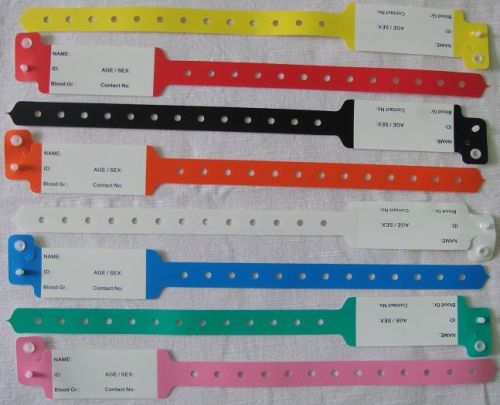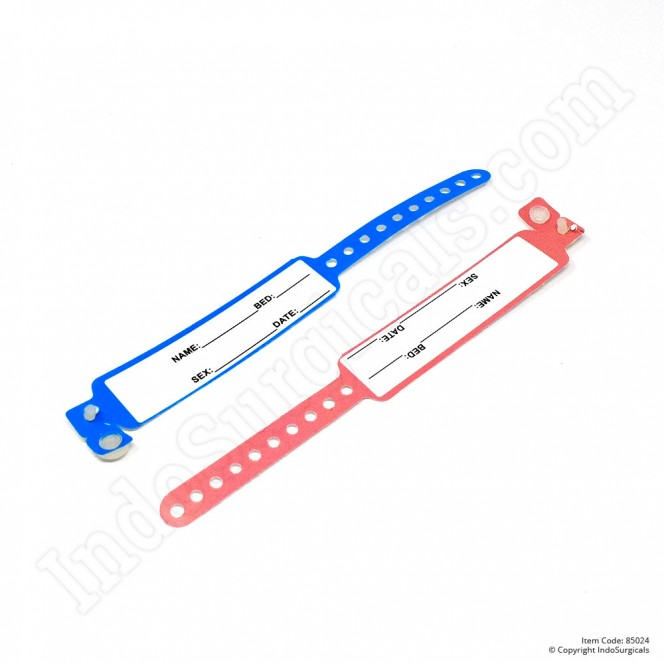Exploring the Numerous Sorts Of Patient Identification Band Made Use Of in Medical Facilities
In the intricate globe of medical care, the important role of Patient Identification bands frequently goes undetected. These bands, differing from easy paper wristbands to innovative RFID bands, form the foundation of Patient safety procedures, ensuring precision in Patient Identification.
Understanding the Value of Patient Identification Bands
While they may appear like plain accessories, Patient Identification bands play an essential role in medical centers. These bands function as a crucial device for validating Patient identity, stopping clinical mistakes related to misidentification. The bands usually present essential info such as the Patient's name, age, blood group, and any kind of known allergies. They allow health care experts to promptly access this critical information, thus assisting in precise and timely medical therapy. Patient Identification bands additionally aid in improving administrative tasks, making sure exact record-keeping and payment. Regardless of their simpleness, these bands personify the concept of Patient safety and security, a keystone of top quality wellness treatment. Without them, the threat of clinical mistakes, and as a result, Patient damage, might considerably enhance.
Typical Paper Wristbands: Their Use and Limitations
Standard paper wristbands have been a staple in Patient Identification across numerous medical facilities. While their use is extensive, they harbor particular restrictions that may influence their efficiency in Patient monitoring. This section will certainly concentrate on the scope of their application and the integral disadvantages related to their usage.
Paper Wristbands: Usage Extent
In the realm of Patient Identification, paper wristbands have actually long held an important role. These bands are commonly utilized in outpatient settings, where the Patient's keep is momentary. The wristbands contain crucial info such as the Patient's name, date of birth, and an one-of-a-kind Identification number. This straightforward, yet efficient system, permits medical specialists to quickly and properly identify individuals, ensuring the right therapy is provided. Paper wristbands are additionally used in emergency situation scenarios, where rapid Identification is extremely important. Their use includes occasions like blood donation drives and mass inoculation programs, better emphasizing their adaptability. Despite developments in modern technology, the humble paper wristband continues to be a dependable and cost-efficient service for Patient Identification in different healthcare situations.
Limitations of Paper Wristbands
Despite their prevalent usage, paper wristbands are not without their downsides. In addition, paper wristbands often do not have the technological capacities of more modern-day alternatives, such as barcoding or RFID chips, restricting their functionality to just displaying created information. Paper wristbands can create discomfort or skin irritability to some clients, specifically when worn for extensive periods.
Barcoded Wristbands: Advancements in Patient Identification
While Patient Identification has long been a vital element of medical care, the advent of barcoded wristbands signifies a significant leap forward. These bands leverage the simplicity of barcoding innovation, allowing for Patient information to be quickly checked and accessed. They boost the rate and precision of Patient Identification, decreasing the risk of medical mistakes connected to misidentification.
Radio Regularity Identification (RFID) Bands: a Step Towards Futuristic Healthcare
The evolution of Patient Identification bands has produced the development of Superhigh frequency Identification (RFID) Bands (patient identification band). These cutting-edge gadgets present key advantages for medical care centers, providing a more reliable and highly advanced means of Patient Identification. The implementation of RFID in healthcare is a substantial step towards an extra advanced method to Patient administration and safety
Recognizing RFID Bands

RFID Bands: Key Benefits
Embracing a future where modern technology and medical care combine, radio regularity Identification bands offer several vital benefits. Mostly, these bands enhance Patient safety and security by giving precise, instant Identification, therefore lowering clinical errors. RFID bands can save a huge amount of Patient information, including case history and allergies, making it possible for personalized treatment. They likewise streamline administrative jobs, as the automated information entry replaces manual procedures, boosting performance and reducing documentation. RFID bands use real-time tracking of individuals, crucial in risky atmospheres such as surgical procedure or intensive treatment. Finally, these bands are immune and resilient to ecological factors, making certain consistent capability. Generally, RFID bands represent a considerable innovation in Patient Identification innovation, profiting both patients and doctor.
Executing RFID in Medical Care
These bands supply Click This Link a seamless method to track and identify individuals, ensuring their safety and security and improving performance in treatment procedures. RFID bands lower medical mistakes by providing exact Patient Identification, which is critical in stopping misdiagnosis or incorrect medication management. Thus, the application of RFID bands is a significant step in the direction of improving Patient safety and security and health care distribution.

Color-Coded Wristbands: Aiding in Quick and Accurate Diagnosis
In the bustling atmosphere of a medical facility, color-coded wristbands have arised as important tools for swift and exact Identification of a client's clinical problem. These wristbands, worn by individuals, lug specific colors that match to various medical conditions or conditions. This system is made to provide instant aesthetic signs to healthcare suppliers, boosting Patient safety and care high quality.
Approaches for Effective Implementation and Administration of Patient ID Bands
Attaining optimum use Patient Identification bands necessitates a well-structured technique for their application and administration. The primary step entails training all wellness employees on the significance of properly applying and checking out these bands. Secondly, healthcare facilities need to systematize using ID bands throughout all divisions, making certain harmony and minimizing disparities. Normal audits must be carried out to verify adherence to policies and to rectify any kind of incongruities. Patient education is also crucial; patients have to Visit Website recognize the function of the bands and the need for their constant wear. patient identification band. It's important to have a back-up plan in place, such as barcode scanning or biometrics, to make certain that Patient Identification is never ever compromised.
Final thought
Patient Identification bands are important in clinical facilities to guarantee security and precision. Reliable implementation and management of these bands can substantially lower clinical mistakes, boost effectiveness, and improve total Patient treatment.
These bands, differing from simple paper wristbands to advanced RFID bands, develop the backbone of Patient safety protocols, making certain accuracy in Patient Identification.The evolution of Patient Identification bands has brought about the introduction of Radio Regularity Identification (RFID) Bands. Generally, RFID bands stand for a substantial advancement in Patient Identification innovation, benefiting both clients and health care suppliers.
RFID bands lower clinical mistakes by important source supplying precise Patient Identification, which is crucial in preventing misdiagnosis or incorrect medicine management. Patient education is also crucial; people have to recognize the function of the bands and the requirement for their constant wear.